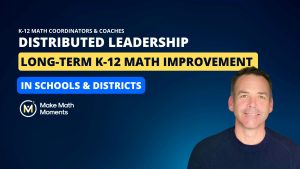What happens when you’re expected to lead change in math instruction—but you don’t have the formal authority to make decisions?
If you’re a math coach, district specialist, department head, or an instructional leader without an official title, this probably sounds familiar. You have a clear vision for what great math teaching looks like. You spend your time thinking about how to improve it. But the people responsible for setting school wide priorities—often principals or administrators—might not share the same focus or urgency.
Here’s the encouraging truth: Leadership doesn’t require a title. It requires influence. And influence can come from any corner of the system, as long as there’s trust, clarity of purpose, and a willingness to lead from alongside—not above.
That’s the foundation of what Keith Ferrazzi calls co-elevation—a model of leadership built on partnership and shared responsibility.
From External Push to Internal Pull in Math Educational Leadership
In Stage 4: Inspire Growth of the Math Improvement Flywheel—this mindset becomes essential. It’s where top-down efforts give way to grassroots momentum, driven by teacher leaders, collaborative teams, and school-based ownership.
For math leaders working at the district or school level, this idea becomes especially powerful in stage 4. At this point, your work is no longer about setting vision or aligning structures—it’s about scaling capacity from within.
That means your “team” can’t just include district administrators or formally titled coaches. It must include classroom teachers, emerging leaders, and even skeptics. The question isn’t just who reports to you?—but rather who is willing to grow with you?
But to do this well, you need to look beyond titles and ask:
- Who are the teachers already demonstrating effective instruction?
- Who do their colleagues naturally seek out for support or inspiration?
- Who is ready to co-lead—not because they were told to, but because they believe in the work?
- Who are the colleagues in my system that will make it easier for me to accomplish my goals?
These are your true team members. Not in position, but in practice.
When you elevate these individuals—by giving them recognition, time, support, and a voice—you seed a culture where professional growth becomes something teachers pursue together, not something done to them. This shift aligns closely with research on distributed leadership and instructional coaching (Spillane, 2006; Knight, 2007), which shows that real change takes root when educators are empowered to lead from where they are.
Case Study: Redefining Leadership in a School Division
When Jordan, a district math leader set out to improve instruction system wide, he knew professional development workshops alone wouldn’t be enough. Real, lasting change had to be grown from within schools, not just delivered from the central office.
He embraced a co-elevation mindset. Rather than focusing solely on formal coaches or content specialists, Jordan expanded his definition of “team” to include classroom teachers, school-based math leads, and most importantly—principals.
He asked: Who are the educators already modeling the type of learning experiences we want to scale? Who do others trust and turn to for ideas? Who is willing to lead, regardless of their role?
These were his partners. Jordan began co-visiting schools with principals, not simply to observe instruction, but to reflect together on bright spots, opportunities, and shared goals. Over time, principals became more than implementers—they became co-designers of the district’s math strategy.
In many schools, principals started identifying their own teacher leaders—those creating rich discussions around reasoning and student thinking. They carved out time in staff meetings for teacher-led “math shares”, where classroom educators showcased strategies or student work. What began as a simple shift became a movement: math became a topic of staff-wide conversation, not just coaching sessions.
As research by Woulfin (2017) and Neufeld & Roper (2009) suggests, involving principals in instructional leadership is key to sustaining coherence and building professional capacity. When principals see themselves as instructional leaders—and when they recognize their teachers as influencers—the conditions for growth multiply.
Why This Works: The Research Behind Co-Elevation
Ferrazzi (2020) argues that co-elevation is effective because it taps into intrinsic motivation and psychological safety—two drivers consistently linked to improved team performance. Educational research backs this up.
- Distributed leadership frameworks (Spillane, 2006) show that leadership is most effective when it is spread across multiple actors in the system, not concentrated at the top.
- Instructional coaching models (Knight, 2011) emphasize partnership and joint problem-solving rather than top-down advice.
- Professional learning communities (DuFour & Eaker, 1998) thrive when educators engage as equals in a shared mission.
- Coaching for coherence (Woulfin, 2017) highlights how district and school leaders must collaborate to align priorities and sustain momentum.
By redefining who is “on the team” and investing in co-leadership with classroom educators and principals, leaders like Jordan activate the most powerful lever for change: a network of educators moving forward together—not because they were told to, but because they want to.
Your Next Move
Take time this month to reflect:
- Who are the educators already living out the vision?
- How can you elevate their voices and multiply their impact?
- Are your Principals positioned as co-leaders, or compliance checkers?
- What space can you create for teacher-led collaboration and sharing?
- Who is on your team?
Because as Ferrazzi reminds us, “You don’t need authority to lead—only the willingness to build trust and move forward together.”
And in a system where real capacity is built from the inside out, that willingness is the spark that keeps the flywheel turning.
References:
- Ferrazzi, K. (2020). Leading Without Authority. Crown Currency.
- Spillane, J. P. (2006). Distributed Leadership. Jossey-Bass.
- Woulfin, S. L., & Rigby, J. G. (2017). Coaching for coherence: How instructional coaches lead change in the evaluation era. Educational Researcher, 46(6), 323-328.
- Knight, J. (2011). Instructional Coaching: A Partnership Approach to Improving Instruction.
- Neufeld, B., & Roper, D. (2009). Coaching: A Strategy for Developing Instructional Capacity. Aspen Institute.
- DuFour, R., & Eaker, R. (1998). Professional Learning Communities at Work. Solution Tree.






